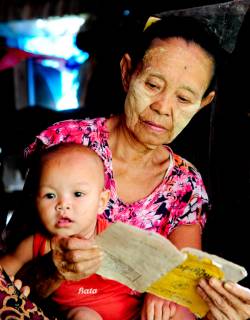 Population ageing is one of the biggest challenges facing East Asia. In Myanmar, currently about 9% of the population is aged above 60 and this is expected to rise rapidly. By 2050, it is estimated that older people will comprise close to a quarter of Myanmar’s overall population.
Population ageing is one of the biggest challenges facing East Asia. In Myanmar, currently about 9% of the population is aged above 60 and this is expected to rise rapidly. By 2050, it is estimated that older people will comprise close to a quarter of Myanmar’s overall population.
The lack of a national census since 1983 has meant there is considerable uncertainty about the size and age composition of Myanmar’s population and therefore little data available to shed light on the nuances of the older populace.
Nationwide survey on ageing
In 2012, HelpAge International contracted John Knodel, one of the region’s leading experts on ageing and demographics, to conduct a nationwide survey to gather comprehensive information (4.5mb) reflecting the situation of older people in Myanmar.
Over two months a total of 4,080 older people were interviewed, a sample covering the whole country, except for Kachin State. The survey was in response to a request from Myanmar’s Ministry of Social Welfare, Relief and Resettlement and with support from the United Nations Population Fund (UNFPA) and Age International.
Similar to other countries in the region, the population of Myanmar is rapidly ageing. This can largely be attributed to a decline in fertility, combined with improved life expectancy. The survey found that even by the standards of South East Asia, older people in Myanmar remain exceptionally close to their families and often receive substantial financial support from their adult children.
Traditional family structures remain strong
Myanmar has an enduring culture of respect for elders and grandparents. Traditional family structures remain strong, with 77% living with at least one child and 95% of older people having at least one child living in the same community. Currently families have an average of four to five children; however fertility rates have already fallen to just two children per woman. Dramatically shrinking family sizes and increasing urban migration will soon put these traditional means of support under strain.
Older people, especially those in rural areas of Myanmar are generally poor with a third of those interviewed living in homes that don’t have electricity and over half lacking running water. On average the homes of older people have few assets or possessions and only 55% felt that their income is regularly sufficient to support their daily needs.
Pensions are rare in Myanmar, especially among older people in rural areas, where the survey found only a few per cent of respondents receive income from a pension. This percentage differs to urban residents where about a fifth of respondents receive pensions.
Using evidence to develop better policies and programmes
From this report, we are able to see an intricate snapshot of the living conditions of older people in Myanmar, which can be supplemented by further in-depth studies to strengthen and expand the evidence base being developed. This growing evidence will enable the Myanmar government and non-government agencies to collaborate on developing informed policies and implementing plans for care services to fill in the gaps wherever needed.
Currently, Myanmar is preparing for its first national census in almost thirty years, which will be conducted in 2014. This census will provide a golden opportunity to gather age-disaggregated data that can guide future policy-making and it is essential that issues of ageing are clearly integrated into its design.
Read more about our work to support older people in Myanmar.
Download the full report (4.5mb) or the executive summary (1.5mb).
Find out more about Myanmar’s ageing population through our Global AgeWatch report card.
